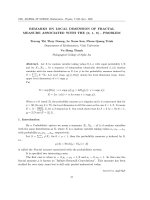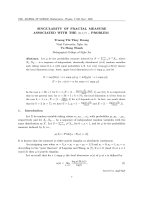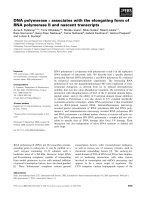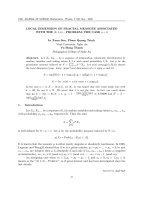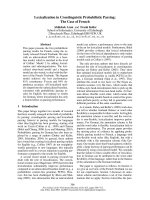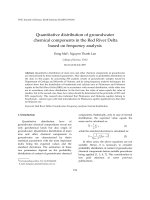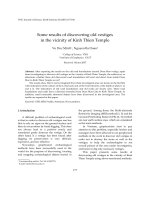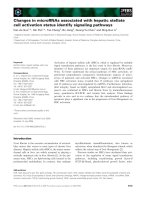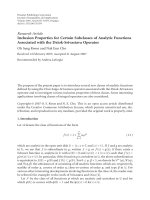Báo cáo "LOCAL DIMENSION OF FRACTAL MEASURE ASSOCIATED WITH THE (0, 1, a) - PROBLEM: THE CASE a = 6 " pptx
Bạn đang xem bản rút gọn của tài liệu. Xem và tải ngay bản đầy đủ của tài liệu tại đây (216.91 KB, 14 trang )
VNU. JOURNAL OF SCIENCE, Mathematics - Physics. T.XXI, N
0
1 - 2005
LOCAL DIMENSION OF FRACTAL MEASURE ASSOCIATED
WITH THE (0, 1,a) -PROBLEM:THECASEa =6
Le Xuan Son, Pham Quang Trinh
Vinh Univ ersity, Nghe An
Vu Hong Thanh
Pedagogical College of Nghe An
Abstract.
Let X
1
,X
2
, be a sequence of independent, identically distributed(i.i.d)
random variables each taking values
0, 1,a with equal probabilit y 1/3.Letµ be the
probability measure induced by
S =
∞
n=1
3
−n
X
n
.Letα(s) (resp.α(s), α(s))denote
the local dimension (resp. lower, upper local dimension) of
s ∈ supp µ,andlet
α = sup{α(s):s ∈ supp µ}; α = inf{α(s):s ∈ supp µ}
E = {α : α(s)=α for some s ∈ supp µ}.
In the case a =3, E =[2/3, 1], see [6]. It was hoped that this result holds true with
a =3k, for any k ∈ N. We prove that it is not the case. In fact, our result shows
that for
k =2(a =6), α =1, α =1−
log(1+
√
5)−log 2
2log3
≈ 0.78099 and E =[1−
log(1+
√
5)−log 2
2log3
, 1].
1. Introduction
Let X
1
,X
2
, be a sequence of i.i.d random variables each taking values a
1
,a
2
, ,a
m
with probability p
1
,p
2
, ,p
m
respectively. Then the sum
S =
∞
n=1
ρ
n
X
n
is well defined for 0 < ρ < 1. Let µ be the probability measure induced by S, i.e.,
µ(A)=Prob{ω : S(ω) ∈ A}.
It is known that the measure µ is either purely singular or absolutely continuous. In 1996,
Lagarias and Wang[8] showed that if m is a prime number, p
1
= p
2
= = p
m
=1/m and
a
1
, ,a
m
are int egers then µ is absolutely if and only if {a
1
,a
2
, ,a
m
} forms a complete
system(modm), i.e., a
1
≡ 0(modm),a
2
≡ 1(modm), ,a
m
≡ m −1(modm).
An intriguing case when m =3,p
1
= p
2
= p
3
=
1
3
and a
1
=0,a
2
=1,a
3
=3,
known as the ”(0, 1, 3) −P roblem”, is of great interest and has been investigated since the
last decade.
Typeset by A
M
S-T
E
X
31
32 Le Xuan Son, Pham Quang Trinh, Vu Hong Thanh
Let us recall that for s ∈ supp µ the local dimention α(s)ofµ at s is defined by
α(s)= lim
h→0
+
log µ(B
h
(s))
log h
, (1)
provided that the limit exists, where B
h
(s) denotes the ball centered at s with radius h.If
the limit (1) does not exist, we define the upper and lower local dimension, denoted
α(s)
and α
(s), by taking the upper and lower limits respectively.
Observe that the local dimension is a function defined in the supp µ.Denote
α =sup{α(s):s ∈ supp µ} ; α =inf{α(s):s ∈ supp µ};
and
E = {α : α(s)=α for some s ∈ supp µ}
be the attainable values of α(s), i.e., the range o f α.
In [6], T. Hu, N. Nguyen and T. Wang have investigated the ”(0, 1, 3)- Problem”
andshowedthatE =[2/3, 1]. In this note we consider the following general problem.
Problem. Describle the local dimension for the (0, 1,a)- problem, where a ∈ N is a natural
number.
Note that the local dimension is an important characteristic of singular measures.
For a =3k +2 the measure µ is absolutely continuous, therefore we only need to consider
the case a =3k or a =3k +1,k ∈ N.Fora =3k it is conjectured that the local dimension
is still the same as a =3,itmeansthatE =[2/3, 1]. Our aim in this note is to disprove
this conjecture. In fact, our result is the following:
Main Theorem. For a =6wehave
α =1, α =1−
log(1+
√
5)−log 2
2log3
and E =[1−
log(1+
√
5)−log 2
2log3
, 1].
The proof of the Main Theorem will be given in Section 3. The next section we establish
some auxiliary results used in the proof of the Main T heorem.
2. Auxiliary Results
Let X
1
,X
2
, be a sequence o f i.i.d random variables e ach taking values 0, 1, 6
with equal probability 1/3. Let S =
∞
n=1
3
−n
X
n
, S
n
=
n
i=1
3
−i
X
i
be the n-partial
sum of S, and let µ, µ
n
be the probability measures induced by S, S
n
respectively. For any
s =
∞
n=1
3
−n
x
n
∈ supp µ, x
n
∈ D: = {0, 1, 6},lets
n
=
n
i=1
3
−i
x
i
be it’s n-partial sum.
It is easy to see that for any s
n
,s
n
∈ supp µ
n
, |s
n
− s
n
| = k3
−n
for some k ∈ N,andfor
any interval between two consecutive points in supp µ
n
there exists at least one point in
supp µ
n+1
.Let
s
n
= {(x
1
,x
2
, ,x
n
) ∈ D
n
:
n
i=1
3
−i
x
i
= s
n
}.
Then we have
µ
n
(s
n
)=#s
n
3
−n
for every n, (2)
where # A denotes the cardinality of set A.
Local dimension of fractal measure associated with 33
Two sequences (x
1
,x
2
, ,x
n
)and(x
1
,x
2
, ,x
n
)inD
n
are said to be equivalent,
denoted by (x
1
,x
2
, ,x
n
) ≈ (x
1
,x
2
, ,x
n
)if
n
i=1
3
−i
x
i
=
n
i=1
3
−i
x
i
.Thenwehave
2.1.Claim. Assume that (x
1
,x
2
, ,x
n
)and(x
1
,x
2
, ,x
n
)inD
n
.If(x
1
,x
2
, ,x
n
) ≈
(x
1
,x
2
, ,x
n
)andx
n
>x
n
then x
n
=6,x
n
=0.
Proof.Since(x
1
,x
2
, ,x
n
) ≈ (x
1
,x
2
, ,x
n
), we have
3
n−1
(x
1
−x
1
)+3
n−2
(x
2
− x
2
)+ +3(x
n−1
− x
n−1
)+x
n
− x
n
=0,
which implies x
n
−x
n
≡ 0 (mod 3), and by virtue of x
n
>x
n
we have x
n
−x
n
= 6. Hence
x
n
=6,x
n
= 0. The claim is proved.
Consequece 1. a) Let s
n+1
∈ supp µ
n+1
and s
n+1
= s
n
+
1
3
n+1
,s
n
∈ supp µ
n
.Wehave
#s
n+1
=#s
n
for evrery n.
b) For any s
n
,s
n
∈ supp µ
n
such that s
n
− s
n
=
1
3
n
,wehave
#s
n
a #s
n
.
Proof. Observe that a) is a directive consequence of Claim 2.1.
b) It is easy to see that if s
n
− s
n
=
1
3
n
,thens
n
= s
n−1
+
1
3
n
and s
n
= s
n−1
+
0
3
n
, where s
n−1
∈ supp µ
n−1
. Therefore from a) it follows that
#s
n
=#s
n−1
a #s
n
.
Remark 1. Observe that from |s
n
−s
n
| = k3
−n
, it follows that if s
n+1
∈ supp µ
n+1
and s
n+1
= s
n
+
1
3
n+1
then s
n+1
can not be represented in the forms
s
n+1
= s
n
+
0
3
n+1
, or s
n+1
= s
n
+
6
3
n+1
,
where s
n
,s
n
,s
n
∈ supp µ
n
. Thus, for any s
n+1
∈ supp µ
n+1
has a t most two representa-
tions throught poin ts in supp µ
n
.
2.2. Claim. Assume that s
n
,s
n
∈ supp µ
n
,n≥ 3. Then we have
a) If s
n
− s
n
=
1
3
n
, then there are three following cases for the representation of
s
n
,s
n
:
1. s
n
= s
n−1
+
1
3
n
; s
n
= s
n−1
+
0
3
n
,
2. s
n
= s
n−2
+
6
3
n−1
+
1
3
n
; s
n
= s
n−2
+
1
3
n−1
+
6
3
n
, or
3. s
n
= s
n−2
+
0
3
n−1
+
1
3
n
; s
n
= s
n−2
+
1
3
n−1
+
6
3
n
,
where s
n−1
∈ supp µ
n−1
and s
n−2
,s
n−2
∈ supp µ
n−2
.
b) If s
n
−s
n
=
2
3
n
then there are four following cases for the representation of s
n
,s
n
:
1. s
n
= s
n−2
+
0
3
n−1
+
6
3
n
; s
n
= s
n−2
+
1
3
n−1
+
1
3
n
,
2. s
n
= s
n−2
+
1
3
n−1
+
0
3
n
; s
n
= s
n−2
+
0
3
n−1
+
1
3
n
,
3. s
n
= s
n−2
+
6
3
n−1
+
6
3
n
; s
n
= s
n−2
+
1
3
n−1
+
1
3
n
, or
4. s
n
= s
n−2
+
1
3
n−1
+
0
3
n
; s
n
= s
n−2
+
6
3
n−1
+
1
3
n
,
34 Le Xuan Son, Pham Quang Trinh, Vu Hong Thanh
where s
n−1
∈ supp µ
n−1
and s
n−2
,s
n−2
∈ supp µ
n−2
.
Proof.Lets
n
=
n
i=1
3
−i
x
i
and s
n
=
n
i=1
3
−i
x
i
, x
i
,x
i
∈ D.
a) If s
n
−s
n
=
1
3
n
then 3
n−1
(x
1
−x
1
)+3
n−2
(x
2
−x
2
)+ +3(x
n−1
−x
n−1
)+x
n
−x
n
=
1, which implies s
n
− s
n
≡ 1(mod3),hencex
n
− x
n
=1orx
n
−x
n
= −5.
For x
n
− x
n
=1wehavex
n
=1,x
n
=0.Thisisthecase1.a.
For x
n
− x
n
= −5wehavex
n
=1,x
n
=6and
3
n−2
(x
1
− x
1
)+ +3(x
n−2
− x
n−2
)+x
n−1
−x
n−1
=2,
which implies s
n−1
− s
n−1
≡ 2 (mod 3), hence x
n−1
− x
n−1
=5(x
n−1
=6,x
n−1
=1)or
x
n−1
− x
n−1
= −1(x
n−1
=0,x
n−1
= 1) are the cases 2.a, 3.a respectively.
b) The proof is similar to a).
Consequence 2. Let s
n
<s
n
<s
n
be three arbitrary consecutive points in suppµ
n
.
Then either s
n
− s
n
or s
n
− s
n
is not
1
3
n
.
The following fact provides a useful form ula for calculating the local dimention.
2.3. Proposition. For s ∈ supp µ,wehave
α(s)= lim
n→∞
| log µ
n
(s
n
)|
n log 3
,
provided that the limit exists. Otherwise, by taking the upper and lower limits respectively
we get the formulas for
α(s) and α(s).
We first prove:
2.4. Lemma. For any two consecutive points s
n
and s
n
in supp µ
n
we have
µ
n
(s
n
)
µ
n
(s
n
)
a n.
Proof. By (2) it is sufficient to show that
#s
n
#s
n
a n. Wewillprovetheinequalityby
induction. Clearly the inequality holds for n = 1. Suppose that it is true for all n a k.
Let s
k+1
>s
k+1
be two arbitrary consecutive points in supp µ
n+1
.Write
s
k+1
= s
k
+
x
k+1
3
k+1
,s
k
∈ supp µ
k
,x
k+1
∈ D.
We consider the following cases for x
k+1
:
Case 1. x
k+1
=6. s
k+1
= s
k
+
6
3
k+1
= s
k
+
2
3
k
.Lets
k
∈ supp µ
k
be the smallest value
larger than s
k
.
1.a) If s
k
= s
k
+
1
3
k
then s
k+1
= s
k
+
1
3
k+1
, hence by Consequence 1.a, we have
#s
k+1
=#s
k
.Notethatifs
k+1
has a other representation, s
k+1
= s
k
+
0
3
k+1
,s
k
∈
supp µ
k
,thens
k
and s
k
are two consecutive poin ts in supp µ
k
and s
k
<s
k
<s
k
,a
contradiction. It follows that #s
k+1
=#s
k
.Therefore
#s
k+1
#s
k+1
=
#s
k
#s
k
a k<k+1.
Local dimension of fractal measure associated with 35
1.b) If s
k
≥ s
k
+
2
3
k
= s
k+1
. So s
k+1
has at most two representations through s
k
and s
k
( s
k+1
= s
k
+
6
3
k+1
and s
k+1
= s
k
+
0
3
k+1
). It follows that
#s
k+1
a #s
k
+#s
k
.
Since s
k
<s
k
+
1
3
k+1
<s
k+1
a s
k
, s
k+1
∈ (s
k
,s
k+1
). On the other hand s
k
,s
k
are t wo
consecutive points in supp µ
k
,sos
k+1
/∈ supp µ
k
. It follows that
If s
k
+
6
3
k+1
<s
k
+
1
3
k+1
for s
k
∈ supp µ
k
with s
k
<s
k
then s
k+1
= s
k
+
1
3
k+1
. Therefore
#s
k+1
#s
k+1
a
#s
k
+#s
k
#s
k
a k +1.
If there exists s
k
∈ supp µ
k
suc h that s
k
+
1
3
k+1
<s
k
+
6
3
k+1
<s
k+1
(s
k
<s
k
)then
s
k+1
= s
k
+
6
3
k+1
and 0 <s
k
− s
k
<
5
3
k+1
<
2
3
k
,sos
k
= s
k
+
1
3
k
. By Consequece1.b),
#s
k+1
=#s
k
≥#s
k
. Therefore
#s
k+1
#s
k+1
a
#s
k
+#s
k
#s
k
a k +1.
Case 2. x
k+1
=1. s
k+1
= s
k
+
1
3
k+1
.Thens
k+1
= s
k
+
0
3
k+1
.Ifthereexistss
k
∈ supp µ
k
such that s
k+1
= s
k
+
6
3
k+1
then s
k
,s
k
are two consecutive points in supp µ
k
(because
s
k
− s
k
=2/3
k
). Therefore
#s
k+1
#s
k+1
=
#s
k+1
#s
k
a
#s
k
+#s
k
#s
k
a k +1.
Case 3. x
k+1
=0. s
k+1
= s
k
+
0
3
k+1
.Notethatifs
k+1
has other represen tation,
s
k+1
= s
k
+
6
3
k+1
then it was considered in the Case 1. So we may suppose t hat
s
k+1
= s
k
+
6
3
k+1
for all s
k
∈ supp µ
k
. (3)
Then we have #s
k+1
=#s
k
.Write
s
k+1
= s
k
+
x
k+1
3
k+1
,x
k+1
∈ D.
Since s
k+1
= s
k
+
0
3
k+1
∈ supp µ
k
and x
k+1
=0,x
k+1
=1orx
k+1
= 6. Which implies
#s
k+1
=#s
k
. We claim that s
k
and s
k
are two consecutive points in supp µ
k
.
In fact, if there exists s
k
∈ supp µ
k
suc h that s
k
<s
k
<s
k
= s
k+1
,then
s
k+1
= s
k
+
6
3
k+1
(4)
(If it is not the case, s
k+1
= s
k
+
1
3
k+1
<s
k
<s
k
= s
k+1
,thens
k+1
and s
k+1
are not
consecutive).
36 Le Xuan Son, Pham Quang Trinh, Vu Hong Thanh
Since s
k+1
and s
k+1
are two consecutive points, s
k
<s
k+1
= s
k
+
6
3
k+1
= s
k
+
2
3
k
,
hence
s
k
= s
k
+
1
3
k
. (5)
From Consequence 2 and (3),
s
k
+
6
3
k+1
= s
k
+
2
3
k
<s
k
= s
k+1
. (6)
From (4), (5) and (6) we get s
k+1
= s
k
+
6
3
k+1
= s
k
+
2
3
k
= s
k
+
1
3
k
<s
k
+
6
3
k+1
<
s
k
= s
k+1
, a contradiction to s
k+1
and s
k+1
are two consecutive points.
Therefore
#s
k+1
#s
k+1
=
#s
k
#s
k
a k<k+1.
ProofofProposition2.3.We first show that for rgiven ≥ 1andforanys ∈ supp µ
if there exists lim
n→∞
log µ(B
r3
−n
(s))
log(r3
−n
)
, then
α(s)= lim
n→∞
log µ(B
r3
−n
(s))
log(r3
−n
)
=lim
n→∞
log µ(B
r3
−n
(s))
log 3
−n
. (7)
Indeed, for 0 <ha 1taken such that 3
−n−1
<
h
r
a 3
−n
.Then
log µ(B
r3
−n
(s))
log(r3
−n−1
)
a
log µ(B
h
(s))
log h
a
log µ(B
r3
−n−1
(s))
log(r3
−n
)
.
Since lim
n→∞
log(r3
−n−1
)
log(r3
−n
)
=1,wehave
lim
n→∞
log µ(B
r3
−n
(s))
log(r3
−n−1
)
=lim
n→∞
log µ(B
r3
−n−1
(s))
log(r3
−n
)
=lim
n→∞
log µ(B
r3
−n
(s))
log(r3
−n
)
.
Therefore, (7) follows. Since
|S −S
n
| a 6
∞
i=1
3
−n−i
=3.3
−n
,
we have
µ(B
3
−n
(s)) = Prob(|S −s| a 3
−n
)
a Prob(|S
n
− s| a 3
−n
+3.3
−n
=4.3
−n
)
= µ
n
(B
r3
−n
(s)), (8)
where r =4.
Similarly, we obtain
µ
n
(B
r3
−n
(s)) a µ(B
(r+3)3
−n
(s)).
Local dimension of fractal measure associated with 37
From the latter and (8) we get
log µ(B
(r+3)3
−n
(s))
log 3
−n
a
log µ
n
(B
r3
−n
(s))
log 3
−n
a
log µ(B
3
−n
(s))
log 3
−n
.
Letting n →∞, by (7) we obtain
α(s)= lim
n→∞
log µ
n
(B
r3
−n
(s))
log 3
−n
. (9)
Observe that B
r3
−n
(s)containss
n
and at most six consecutive points in supp µ
n
(because 2r = 8 and by Consequence 2). By Lemma 2.4,
log µ
n
(s
n
)
log 3
−n
≥
log µ
n
(B
r3
−n
(s))
log 3
−n
≥
log[6n
5
µ
n
(s
n
)]
log 3
−n
.
From the latter and (9) we get
α(s)= lim
n→∞
log µ
n
(s
n
)
log 3
−n
=lim
n→∞
| log µ
n
(s
n
)|
n log 3
.
The proposition is proved.
For each infinite sequence x =(x
1
,x
2
, ) ∈ D
∞
defines a point s ∈ supp µ by
s = S(x):=
∞
n=1
3
−n
x
n
.
Let
x =(x
1
,x
2
, )=(0, 6, 0, 6, ), i.e., x
2k−1
=0,x
2k
=6,k =1, 2, (10)
Then we have
2.5. Claim. For x =(x
1
,x
2
, ) ∈ D
∞
is defined by (10), we have
a)
#s
2n
=#s
2n−1
;
b)
#s
2(n+1)
=#s
2n
+#s
2(n−1)
, (11)
for every n ≥ 2, where s
n
denotes n- partial sum of s = S(x).
Proof. a) Observe that #s
2n
≥#s
2n−1
. On the other hand, let (x
1
,x
2
, , x
2n
) ∈
s
2n
.Ifx
2n
= 6, then by Claim 2.1, x
2n
= 0. It follows that s
2n−1
−s
2n−1
=
2
3
2n−1
,where
s
2n−1
=
2n−1
i=1
3
−i
x
i
. From Claim 2.2.b), it follows that x
2n−1
= 1, a contradiction to
x
2n−1
=0. Thusx
2n
= 6, which implies (x
1
,x
2
, ,x
2n−1
) ∈s
2n−1
. That means
#s
2n−1
≥#s
2n
.
Therefore
#s
2n
=#s
2n−1
.
38 Le Xuan Son, Pham Quang Trinh, Vu Hong Thanh
b) For any element (x
1
,x
2
, ,x
2n
,x
2n+1
,x
2n+2
) ∈s
2n+2
, from the proof of a) we
have (x
1
,x
2
, ,x
2n+1
) ∈s
2n+1
.So,byClaim2.1,x
2n+1
=0orx
2n+1
=6(because
x
2n+1
=0).
If x
2n+1
=0then(x
1
,x
2
, ,x
2n
) ∈s
2n
.
If x
2n+1
=6,since(x
1
,x
2
, ,x
2n
, 6, 6) ≈ (x
1
,x
2
, ,x
2n−1
,x
2n
, 0, 6), s
2n
−s
2n
=
2
3
2n
,wheres
2n
=
2n
i=1
3
−i
x
i
. By Claim 2.2.b) and x
2n
=6wehavex
2n−1
= x
2n
=1,
which implies (x
1
,x
2
, ,x
2n−2
) ∈s
2n−2
(because (0, 6, 0) ≈ (1, 1, 6)). Let
A = {(x
1
,x
2
, ,x
2n−2
,x
2n−1
,x
2n
, 0, 6) : (x
1
,x
2
, ,x
2n
) ∈s
2n
},
B = {(y
1
,y
2
, ,y
2n−2
, 1, 1, 6, 6) : (y
1
,y
2
, ,y
2n−2
) ∈s
2n−2
}.
From the above arguments we have
A ∪B = s
2n+2
and A ∩B = ∅.
Therefore
#s
2(n+1)
=#A +#B =#s
2n
+#s
2(n−1)
.
The lemma is proved.
Consequence 3. For s ∈ supp µ is defined as in Claim 2.5 we have
#s
2n
=#s
2n−1
=
√
5
5
[(
1+
√
5
2
)
n+1
− (
1 −
√
5
2
)
n+1
], (12)
for every n ≥ 1.
Proof. It is easy to see that (12) satisfies (11).
2.6. Claim. For s ∈ supp µ is defined as in Claim 2.5 we have
α(s)=1−
log(1 +
√
5) −log 2
2log3
.
Proof.Forn ≥ 2takek ∈ N such that 2k a n<2(k +1). By (12),
√
5
5
(a
k+1
1
− a
k+1
2
) a #s
n
a
√
5
5
(a
k+2
1
− a
k+2
2
),
where a
1
=
1+
√
5
2
,a
2
=
1−
√
5
2
.
It follows that
| log
√
5
5
(a
k+2
1
− a
k+2
2
)3
−2k
|
2(k +1)log3
a
| log µ
n
(s
n
)|
n log 3
a
| log
√
5
5
(a
k+1
1
−a
k+1
2
)3
−2k−2
|
2k log 3
.
Since
lim
k→∞
| log
√
5
5
(a
k+2
1
−a
k+2
2
)3
−2k
|
2(k +1)log3
=lim
k→∞
| log
√
5
5
(a
k+1
1
−a
k+1
2
)3
−2k−2
|
2k log 3
=1−
log a
1
2log3
,
Local dimension of fractal measure associated with 39
by Proposition 2.3 we get
α(s)=1−
log(1 +
√
5) −log 2
2log3
.
The claim is proved.
2.7. Claim. Let x =(x
1
,x
2
, )beasequencedefined by (10). Then we have
3#s
2n−1
< 2#s
2n+1
for every n,
where s = S(x)ands
n
denotes n-partial sum of s.
Proof. Observe that the assertion holds for n =1, 2. For n ≥ 3, by Claim 2.5 we have
2#s
2n+1
=2#s
2n−1
+2#s
2n−3
=3#s
2n−1
−#s
2n−1
+2#s
2n−3
=3#s
2n−1
−#s
2n−3
−#s
2n−5
+2#s
2n−3
=3#s
2n−1
+#s
2n−3
−#s
2n−5
> 3#s
2n−1
.
The claim is proved.
2.8. Claim. Assume that s
n+1
∈ supp µ
n+1
has two representations through poin ts in
supp µ
n
(n>3). Then, either
#s
n+1
=#s
n−1
+#s
n−3
for some s
n−1
∈ supp µ
n−1
and some s
n−3
∈ supp µ
n−3
,
or
#s
n+1
a 2# s
n−2
for some s
n−2
∈ supp µ
n−2
.
Proof. Let s
n+1
= s
n
+
0
3
n+1
= s
n
+
6
3
n+1
, which implies s
n
−s
n
=
2
3
n
, so by Claim 2.2.b),
x
n
=1,x
n
=0orx
n
= 6. We consider the case x
n
=0. Thecasex
n
= 6 is similar. We
have
s
n+1
= s
n−1
+
0
3
n
+
0
3
n+1
= s
n−1
+
1
3
n
+
6
3
n+1
. (13)
We claim that s
n
has only one representation through point s
n−1
∈ supp µ
n−1
.Infact,if
it is not the case, s
n
= s
n−1
+
0
3
n
= s
n−1
+
6
3
n
,then
s
n+1
= s
n−1
+
0
3
n
+
0
3
n+1
= s
n−1
+
6
3
n
+
0
3
n+1
= s
n−1
+
1
3
n
+
6
3
n+1
,
which implies s
n−1
− s
n−1
= s
n−1
− s
n−1
=
1
3
n−1
. a contradiction to Consequence 2.
Hence,
#s
n+1
=#s
n−1
+#s
n−1
.
From (13) yield s
n−1
−s
n−1
=
1
3
n−1
, by Claim 2.2.a), x
n−1
= 1. So that , by Consequence
1.a), #s
n−1
=#s
n−2
.Therefore
#s
n+1
=#s
n−2
+#s
n−1
.
40 Le Xuan Son, Pham Quang Trinh, Vu Hong Thanh
Consider the following cases.
1. If s
n−1
has o nly one representation through some point s
n−2
∈ supp µ
n−2
then
#s
n−1
=#s
n−2
. Without loss of generality we may assume that #s
n−2
≥#s
n−2
.
Then
#s
n+1
=#s
n−2
+#s
n−2
a 2# s
n−2
.
2. If s
n−1
has two representations through points in supp µ
n−2
, s
n−1
= s
n−2
+
0
3
n−1
= s
n−2
+
6
3
n−1
,then
s
n+1
= s
n−2
+
1
3
n−1
+
0
3
n
+
0
3
n+1
= s
n−2
+
0
3
n−1
+
1
3
n
+
6
3
n+1
= s
n−2
+
6
3
n−1
+
1
3
n
+
6
3
n+1
.
Since (1, 0, 0) ≈ (0, 1, 6) ,s
n−2
= s
n−2
, and so s
n−2
−s
n−2
=
2
3
n−2
. Hence, by Claim 2.2.b),
x
n−2
=1. Thus,s
n−2
= s
n−3
+
1
3
n−2
.
We check that s
n−2
has only one representation through some point s
n−3
∈ supp µ
n−3
.
If it is not the cases s
n−2
= s
n−3
+
0
3
n−2
= s
n−3
+
6
3
n−2
,then
s
n+1
= s
n−3
+
0
3
n−2
+
1
3
n−1
+
0
3
n
+
0
3
n+1
= s
n−3
+
6
3
n−2
+
1
3
n−1
+
0
3
n
+
0
3
n+1
= s
n−3
+
1
3
n−2
+
6
3
n−1
+
1
3
n
+
6
3
n+1
,
which implies s
n−3
−s
n−3
= s
n−3
−s
n−3
=
1
3
n−3
. Which is a contradiction to Consequence
2. So, #s
n−2
=#s
n−3
. Therefore
#s
n+1
=#s
n−3
+#s
n−1
.
The claim is proved.
2.9. Claim. Let k ≥ 3 be a natural number such that
#t
2n+1
a #s
2n+1
for all n a k and for every t
2n+1
∈ supp µ
2n+1
.
Then
2#t
2n
a #s
2n+1
+#s
2n−1
for all n a k and for every t
2n
∈ supp µ
2n
,
where s is definedasinClaim2.5ands
n
denotes n-partial sum of s.
Proof. Observe that, if t
2n
has only one representation through point t
2n−1
∈ supp µ
2n−1
then the claim is true. Suppose that t
2n
has two representations through points in
supp µ
2n−1
, by Claim 2.8, either #t
2n
=#t
2n−2
+#t
2n−4
or #t
2n
a 2# t
2n−3
.
1. Let #t
2n
=#t
2n−2
+#t
2n−4
. Putting
t
2n+1
= t
2n−2
+
0
3
2n−1
+
6
3
2n
+
0
3
2n+1
,t
2n−1
= t
2n−4
+
0
3
2n−3
+
6
3
2n−2
+
0
3
2n−1
Local dimension of fractal measure associated with 41
we have
#t
2n+1
≥2#t
2n−2
, #t
2n−1
≥2#t
2n−4
.
It follows that
2#t
2n
=2#t
2n−2
+2#t
2n−4
a #t
2n+1
+#t
2n−1
a #s
2n+1
+#s
2n−1
.
2. #t
2n
a 2#t
2n−3
. By Claims 2.5 and 2.7 we get
2#t
2n
a 4#t
2n−3
a 4# s
2n−3
=#s
2n−3
+3#s
2n−3
a #s
2n−3
+2#s
2n−1
.
=#s
2n+1
+#s
2n−1
.
The claim is proved.
We say that x =(x
1
,x
2
, ,x
n
) ∈ D
n
is a maximal sequence if
#t
n
a #s
n
for every t
n
∈ supp µ
n
,
where s
n
=
n
i=1
3
−i
x
i
.
The following fact given an estimation for the greatest lower bound of local dimension.
2.10. Proposition. For every n, (x
1
,x
2
, ,x
2n+1
)=(0, 6, 0, 6, ,0, 6, 0) is a maximal
sequence.
Proof. We will prove the proposition by induction. By Claim 2.8, it is straightforward to
check t hat the assertion holds for n =1, 2, 3(#s
3
=2, #s
5
=3, #s
7
= 5). Suppose
that it is true for all n a k(k ≥ 3). We show that the proposition is true for n = k +1.
Let t
2(k+1)+1
= t
2k+3
be an arbitrary point in supp µ
2k+3
. Clearly the assertion holds
if t
2k+3
has only one representation through some point in supp µ
2k+2
.Ift
2k+3
has two
representations through poin ts in supp µ
2k+2
then by Claim 2.8 w e have two following
cases:
Case 1. #t
2k+3
=#t
2k+1
+#t
2k−1
for some t
2k+1
∈ supp µ
2k+1
and some t
2k−1
∈
supp µ
2k−1
. Then, by Claim 2.5 w e get
#t
2k+3
a #s
2k+1
+#s
2k−1
=#s
2k+3
.
Case 2. #t
2k+3
a 2#t
2k
for some t
2k
∈ supp µ
2k
. Then, by Claims 2.5 and 2.9 we
have
#t
2k+3
a 2#t
2k
a #s
2k+1
+#s
2k−1
=#s
2k+3
.
Therefore, (x
1
,x
2
, ,x
2n+1
)=(0, 6, 0, 6, ,0, 6, 0) is a maximal sequence. The propo-
sition is proved.
42 Le Xuan Son, Pham Quang Trinh, Vu Hong Thanh
3. ProofofTheMainTheorem
We call an infinite sequence x =(x
1
,x
2
, ) ∈ D
∞
a prime sequence if #s
n
=1
for every n,wheres
n
=
n
i=1
3
−i
x
i
.
3.1. Claim.
α =1,α =1−
log(1+
√
5)−log 2
2log3
=1−
log a
1
2log3
.
Proof. For any prime sequence x =(x
1
,x
2
, )wehave#s
n
=1foreveryn,where
s
n
=
n
i=1
3
−i
x
i
. Therefore, by Proposition 2.3 we get
α = α(s)= lim
n→∞
| log µ
n
(s
n
)|
n log 3
=1,
where s = S(x).
From Claim 2.6 we have
α
a 1 −
log a
1
2log3
.
For any t ∈ supp µ, by Proposition 2.10 #t
2n+1
a #s
2n+1
=
√
5
5
(a
n+2
1
− a
n+2
2
)for
evrey n,wehave
lim
n→∞
| log µ
2n+1
(t
2n+1
)|
(2n +1)log3
≥ lim
n→∞
| log
√
5
5
(a
n+2
1
− a
n+2
2
)3
−2n−1
|
2(n +1)log3
=1−
log a
1
2log3
, (14)
where t
n
be n- partial sum of t. On the other hand, since #t
2n
a #s
2n+1
,
lim
n→∞
| log µ
2n
(t
2n
)|
(2n)log3
≥ lim
n→∞
| log
√
5
5
(a
n+2
1
− a
n+2
2
)3
−2n
|
2(n)log3
=1−
log a
1
2log3
. (15)
Combinating (14) and (15) w e get
α
≥ 1 −
log a
1
2log3
.
Therefore
α
=1−
log a
1
2log3
=1−
log(1 +
√
5) −log 2
2log3
.
The claim is proved.
To complete the proof of our Main Theorem it remains to show that E =[1−
log(1+
√
5)−log 2
2log3
, 1], i.e., for any β ∈ (1−
log a
1
2log3
, 1) there exists s ∈ supp µ for which α(s)=β.
Let r =2(1−β)
log 3
log a
1
.Itiseasytoseethat0<r<1.
For i =1, 2, , define
k
i
=
2i +1 if i is odd;
[
2i(1−r)
r
]ifi is even,
where [x] denotes the largest integer a x.
Let n
j
=
j
i=1
k
i
and let
E
j
= {i : i a j and i is even} ; O
j
= {i : i a j and i is odd},
Local dimension of fractal measure associated with 43
e
j
=
i∈E
j
k
i
; o
j
=
i∈O
j
k
i
.
Then n
j
= o
j
+ e
j
.
3.2. Claim. With the above notation we ha ve
lim
j→∞
j
n
j
=0; lim
j→∞
n
j−1
n
j
=1and lim
j→∞
o
j
n
j
= r.
Proof. The proof of the first limit is trivial. The second limit follows from the first one.
To prove the third limit, without loss of generality we may assume that j =2k +1. Then
we have o
j
=2
k
i=0
(2i +1)+k +1=(k + 1)(2k +3). Since
4(1 −r)
r
k
i=1
i −k a
k
i=1
[
4i(1 −r)
r
] a
4(1 − r)
r
k
i=1
i,
2(1 −r)
r
k(k +1)−k a e
j
a
2(1 −r)
r
k(k +1).
Hence
(k +1)(2k +3)
(k + 1)(2k +3)+
2(1−r)
r
k(k +1)
a
o
j
n
j
a
(k +1)(2k +3)
(k +1)(2k +3)+
2(1−r)
r
k(k +1)−k
.
Therefore
lim
j→∞
o
j
n
j
= r.
The claim is proved.
We define s ∈ supp µ by s = S(x), where
x =(0, 6, 0,
k
1
=3
1, 1, ,1,
k
2
0, 6, 0, 6, 0,
k
3
=5
1, 1, ,1,
k
3
). (16)
Note that, for i ∈ O
j
, from (12),
#s
k
i
=
√
5
5
(a
k
i
+3
2
1
− a
k
i
+3
2
2
)=
⎧
⎨
⎩
>
√
5
5
a
k
i
+3
2
1
<
√
5
5
a
k
i
+3
2
+1
1
.
(17)
For s ∈ supp µ is defined (16) and for n
j−1
a n<n
j
we have
i∈O
j−1
#s
k
i
a #s
n
a
i∈O
j
#s
k
i
.
Hence, by (17) yield
(
√
5
5
)
j−1
2
a
o
j−1
2
+
3
2
j−1
2
1
a #s
n
a (
√
5
5
)
j+1
2
a
o
j
2
+
5
2
j+1
2
1
,
44 Le Xuan Son, Pham Quang Trinh, Vu Hong Thanh
which implies
log[(
√
5
5
)
j−1
2
a
o
j−1
2
+
3
2
j−1
2
1
]
n
j
log 3
a
log #s
n
n log 3
a
log[(
√
5
5
)
j+1
2
a
o
j
2
+
5
2
j+1
2
1
]
n
j−1
log 3
.
From Claim 3.1 we get
lim
n→∞
log #s
n
n log 3
=
r
2
log a
1
log 3
.
Therefore
α(s)= lim
n→∞
| log #s
n
3
−n
|
n log 3
=1− lim
n→∞
log #s
n
n log 3
=1−
r
2
log a
1
log 3
= β.
The Main Theorem is proved.
Acknowledgements. The authors are grateful to Professor To Nhu Nguyen for his
helpful suggestions and valuable discussions during the preparation of this paper.
References
1. K. J. Falconer, Techniques in Fractal Geometry, John Wiley & Sons, 1997.
2. K. J. Falconer, Fractal Geometry, Mathematical Foundations and Applications,John
Wiley & Sons, 1993.
3. A. Fan, K. S. Lau and S. M. Ngai, Iterated function systems with overlaps, Asian
J. Math. 4(2000), 527 - 552.
4. T. Hu, The local dimensions of the Bernoulli convolution associated with the golden
number, Trans. Amer. Math. Soc. 349(1997), 2917 - 2940.
5. T. Hu and N. Nguyen, Local dimensions of fractal probability measures a ssociated
with equal probability weight, Preprint.
6. T. Hu, N. Nguyen and T. Wang, Local dimensions of the probability measure asso-
ciated with the (0, 1, 3) - problem, Preprint.
7. T. Hu, Some open questions related to Probability, Fractal, Wavelets, East - West
J. of Math. Vol2,No1(2000), 55-71.
8. J. C. Lagarias and Y. Wang, Tiling the line with translates of one tile, Inventions
Math. 124(1996), 341 - 365.
9. S. M. Ngai and Y. Wang, Hausdorff dimention of the self - similar sets with over-
laps,J. London Math. Soc. (to appear).
